人教版高中英语必修四 Unit4 Body Language reading 课件
- 格式:pptx
- 大小:4.28 MB
- 文档页数:23
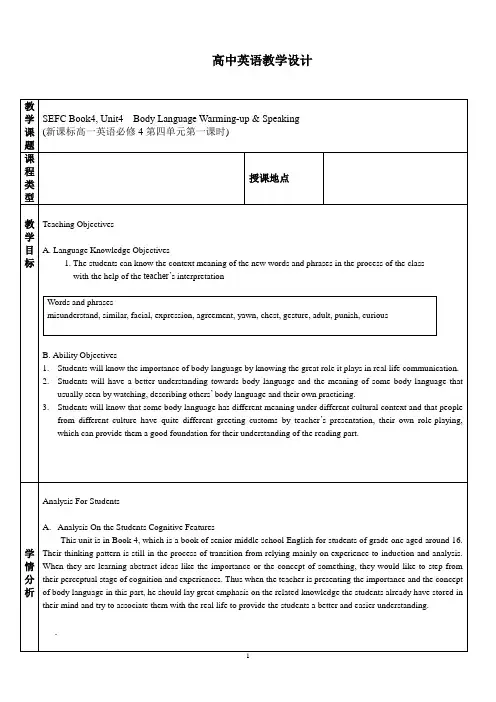
1 高中英语教学设计
教学课题 SEFC Book4, Unit4 Body Language Warming-up & Speaking
(新课标高一英语必修4第四单元第一课时)
课程类型 授课地点
教学目标
Teaching Objectives
A. Language Knowledge Objectives
1. The students can know the context meaning of the new words and phrases in the process of the class
with the help of the teacher’s interpretation
Words and phrases
misunderstand, similar, facial, expression, agreement, yawn, chest, gesture, adult, punish, curious
B. Ability Objectives
1. Students will know the importance of body language by knowing the great role it plays in real life communication.
2. Students will have a better understanding towards body language and the meaning of some body language that
usually seen by watching, describing others’ body language and their own practicing.
3. Students will know that some body language has different meaning under different cultural context and that people
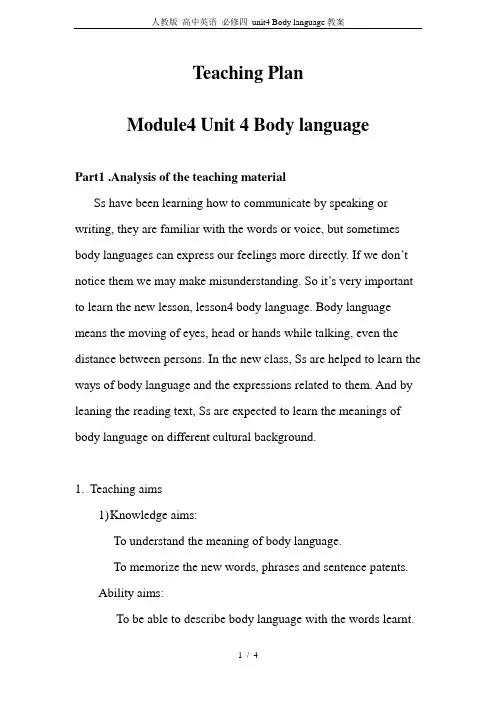
人教版 高中英语 必修四 unit4 Body language教案
1 / 4 Teaching Plan
Module4 Unit 4 Body language
Part1 .Analysis of the teaching material
Ss have been learning how to communicate by speaking or
writing, they are familiar with the words or voice, but sometimes
body languages can express our feelings more directly. If we don’t
notice them we may make misunderstanding. So it’s very important
to learn the new lesson, lesson4 body language. Body language
means the moving of eyes, head or hands while talking, even the
distance between persons. In the new class, Ss are helped to learn the
ways of body language and the expressions related to them. And by
leaning the reading text, Ss are expected to learn the meanings of
body language on different cultural background.
1. Teaching aims
1) Knowledge aims:
To understand the meaning of body language.
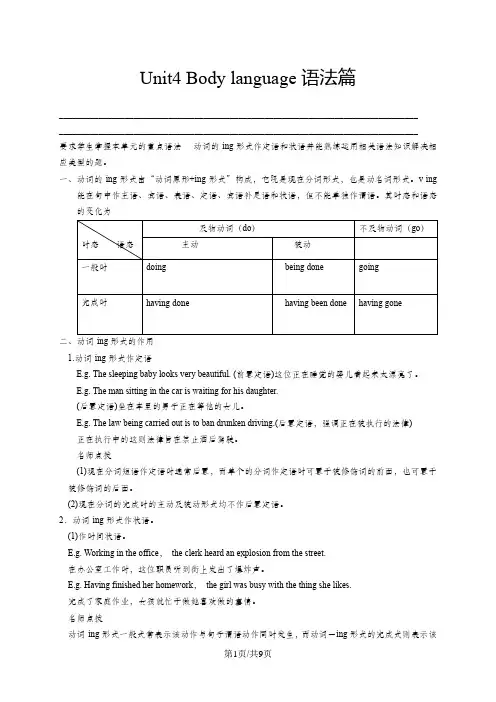
第1页/共9页 Unit4 Body language语法篇
__________________________________________________________________________________
__________________________________________________________________________________
要求学生掌握本单元的重点语法----动词的-ing形式作定语和状语并能熟练运用相关语法知识解决相应类型的题。
一、动词的-ing形式由“动词原形+ing形式”构成,它既是现在分词形式,也是动名词形式。v-ing能在句中作主语、宾语、表语、定语、宾语补足语和状语,但不能单独作谓语。其时态和语态的变化为
时态 语态 及物动词(do) 不及物动词(go)
主动 被动
一般时 doing being done going
完成时 having done having been done having gone
二、动词-ing形式的作用
1.动词-ing形式作定语
E.g. The sleeping baby looks very beautiful. (前置定语)这位正在睡觉的婴儿看起来太漂亮了。
E.g. The man sitting in the car is waiting for his daughter.
(后置定语)坐在车里的男子正在等他的女儿。
E.g. The law being carried out is to ban drunken driving.(后置定语,强调正在被执行的法律)
正在执行中的这则法律旨在禁止酒后驾驶。
名师点拨
(1)现在分词短语作定语时通常后置,而单个的分词作定语时可置于被修饰词的前面,也可置于被修饰词的后面。
(2)现在分词的完成时的主动及被动形式均不作后置定语。
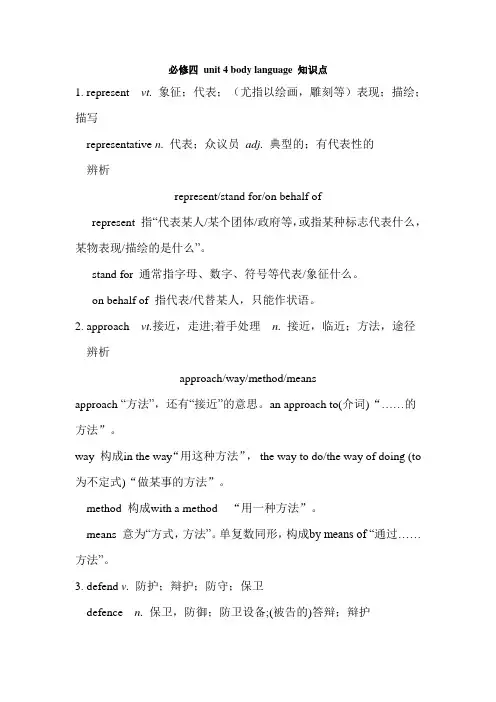
必修四 unit 4 body language 知识点
1. represent vt. 象征;代表;(尤指以绘画,雕刻等)表现;描绘;描写
representative n. 代表;众议员 adj. 典型的;有代表性的
辨析
represent/stand for/on behalf of
represent 指“代表某人/某个团体/政府等,或指某种标志代表什么,某物表现/描绘的是什么”。
stand for 通常指字母、数字、符号等代表/象征什么。
on behalf of 指代表/代替某人,只能作状语。
2. approach vt.接近,走进;着手处理 n. 接近,临近;方法,途径
辨析
approach/way/method/means
approach “方法”,还有“接近”的意思。an approach to(介词)“……的方法”。
way 构成in the way“用这种方法”, the way to do/the way of doing (to为不定式)“做某事的方法”。
method 构成with a method “用一种方法”。
means 意为“方式,方法”。单复数同形,构成by means of “通过……方法”。
3. defend v. 防护;辩护;防守;保卫
defence n. 保卫,防御;防卫设备;(被告的)答辩;辩护 常用结构:
defend oneself 自卫,辩护
defend oneself from/against 保护自己免受……
in defence of 保卫……;为……辩护
注意: defence后接“入侵者”或“造成危害者”时用介词 against;若后接“被保护者”时用介词 of。
4. major adj. 主要的; vi. 主修
majority n.大多数 minority n.少数,少数民族
5. misunderstand-misundstood-misunderstood vt. 误解,误会
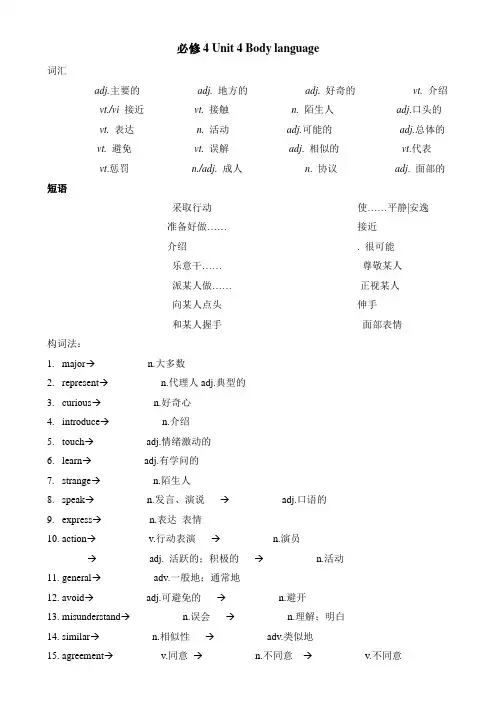
必修4 Unit 4 Body language
词汇
_________ adj.主要的 __________ adj. 地方的 __________ adj. 好奇的 __________ vt. 介绍
__________ vt./vi 接近__________vt. 接触 __________ n. 陌生人 __________ adj.口头的
__________ vt. 表达 __________ n. 活动 __________ adj.可能的 __________ adj.总体的
__________vt. 避免 __________ vt. 误解 __________adj. 相似的 __________ vt.代表
__________ vt.惩罚 __________ n./adj. 成人 __________ n. 协议 __________ adj. 面部的
短语
________________________ 采取行动 ________________________ 使……平静|安逸
________________________准备好做…… ________________________接近
________________________介绍 ________________________. 很可能
________________________ 乐意干…… ________________________ 尊敬某人
________________________ 派某人做…… ________________________ 正视某人
________________________ 向某人点头 ________________________伸手
________________________ 和某人握手 ________________________ 面部表情
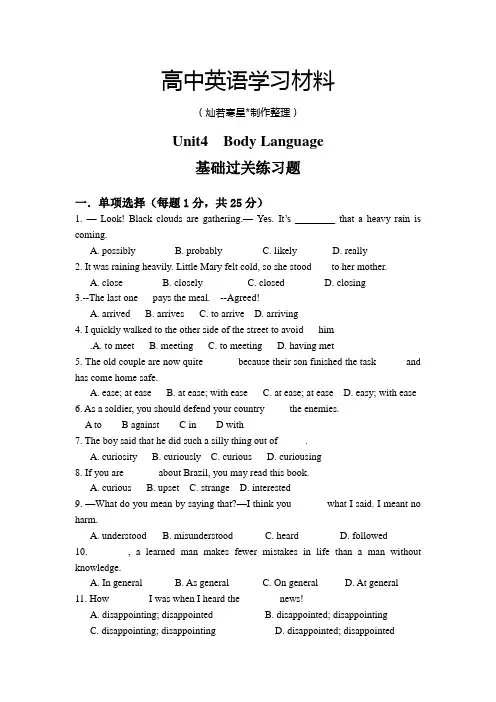
高中英语学习材料
(灿若寒星*制作整理)
Unit4 Body Language
基础过关练习题
一.单项选择(每题1分,共25分)
1. — Look! Black clouds are gathering.— Yes. It’s ________ that a heavy rain is
coming.
A. possibly B. probably C. likely D. really
2. It was raining heavily. Little Mary felt cold, so she stood ___ to her mother.
A. close B. closely C. closed D. closing
3.--The last one __ pays the meal. --Agreed!
A. arrived B. arrives C. to arrive D. arriving
4. I quickly walked to the other side of the street to avoid __ him
.A. to meet B. meeting C. to meeting D. having met
5. The old couple are now quite ______ because their son finished the task _____ and
has come home safe.
A. ease; at ease B. at ease; with ease C. at ease; at ease D. easy; with ease
6. As a soldier, you should defend your country ____ the enemies.
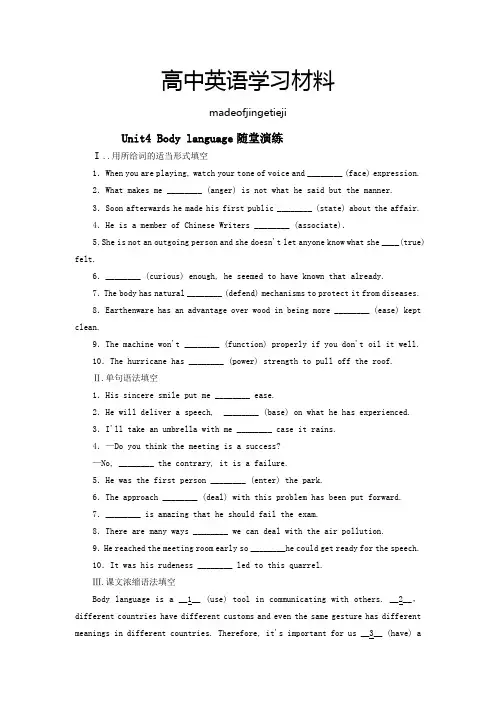
高中英语学习材料
madeofjingetieji
Unit4 Body language随堂演练
Ⅰ..用所给词的适当形式填空
1.When you are playing, watch your tone of voice and ________ (face) expression.
2.What makes me ________ (anger) is not what he said but the manner.
3.Soon afterwards he made his first public ________ (state) about the affair.
4.He is a member of Chinese Writers ________ (associate).
5.She is not an outgoing person and she doesn't let anyone know what she ____(true)
felt.
6.________ (curious) enough, he seemed to have known that already.
7.The body has natural ________ (defend) mechanisms to protect it from diseases.
8.Earthenware has an advantage over wood in being more ________ (ease) kept
clean.
9.The machine won't ________ (function) properly if you don't oil it well.
10.The hurricane has ________ (power) strength to pull off the roof.
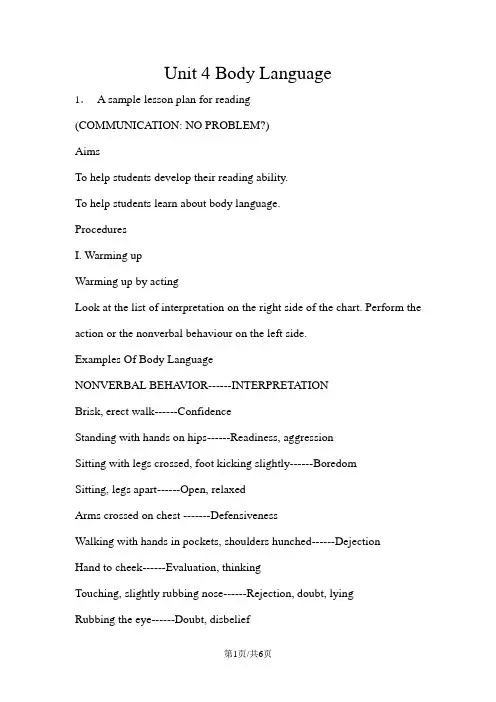
第1页/共6页 Unit 4 Body Language
1. A sample lesson plan for reading
(COMMUNICATION: NO PROBLEM?)
Aims
To help students develop their reading ability.
To help students learn about body language.
Procedures
I. Warming up
Warming up by acting
Look at the list of interpretation on the right side of the chart. Perform the
action or the nonverbal behaviour on the left side.
Examples Of Body Language
NONVERBAL BEHAVIOR------INTERPRETATION
Brisk, erect walk------Confidence
Standing with hands on hips------Readiness, aggression
Sitting with legs crossed, foot kicking slightly------Boredom
Sitting, legs apart------Open, relaxed
Arms crossed on chest -------Defensiveness
Walking with hands in pockets, shoulders hunched------Dejection
Hand to cheek------Evaluation, thinking
Touching, slightly rubbing nose------Rejection, doubt, lying
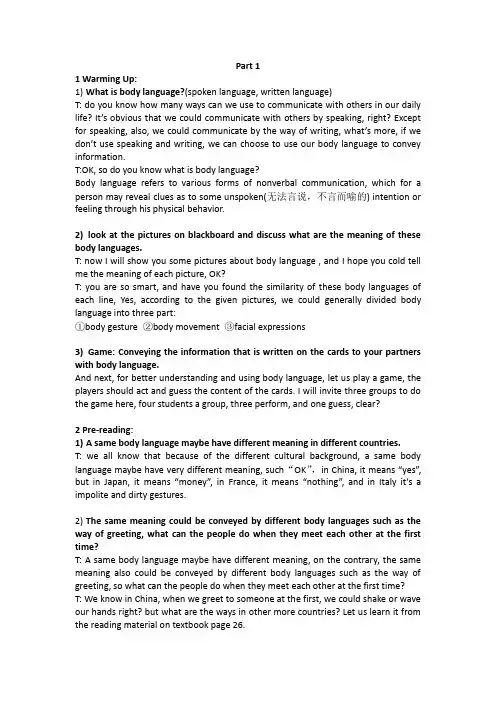
Part 1
1 Warming Up:
1) What is body language?(spoken language, written language)
T: do you know how many ways can we use to communicate with others in our daily
life? It’s obvious that we could communicate with others by speaking, right? Except
for speaking, also, we could communicate by the way of writing, what’s more, if we
don’t use speaking and writing, we can choose to use our body language to convey
information.
T:OK, so do you know what is body language?
Body language refers to various forms of nonverbal communication, which for a
person may reveal clues as to some unspoken(无法言说,不言而喻的) intention or
feeling through his physical behavior.
2) look at the pictures on blackboard and discuss what are the meaning of these
body languages.
T: now I will show you some pictures about body language , and I hope you cold tell
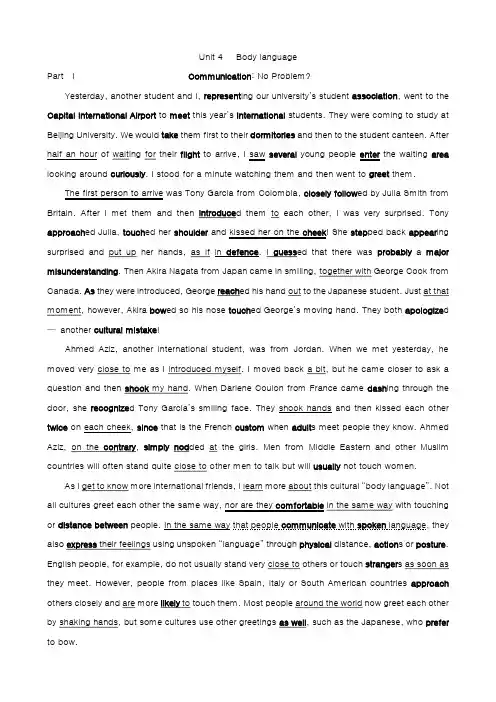
Unit 4 Body language
Part I Communication: No Problem?
Yesterday, another student and I, representing our university’s student association, went to the
Capital International Airport to meet this year’s international students. They were coming to study at
Beijing University. We would take them first to their dormitories and then to the student canteen. After
half an hour of waiting for their flight to arrive, I saw several young people enter the waiting area
looking around curiously. I stood for a minute watching them and then went to greet them.
The first person to arrive was Tony Garcia from Colombia, closely followed by Julia Smith from
Britain. After I met them and then
introduced them to each other, I was very surprised. Tony
approached Julia,
touched her shoulder and kissed her on the cheek! She stepped back appearing
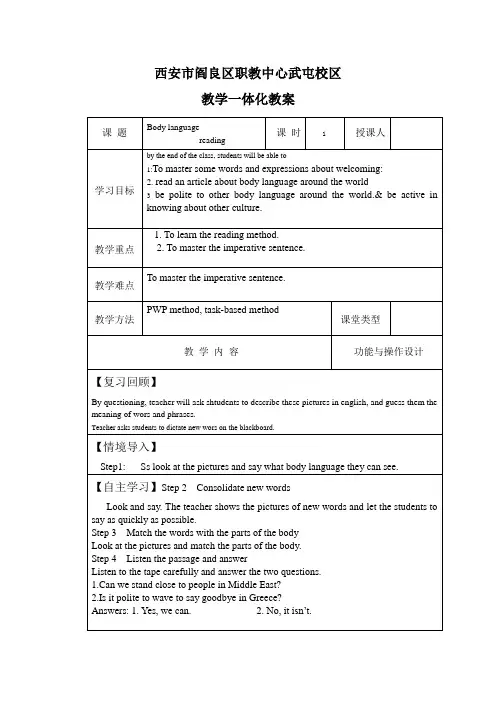
西安市阎良区职教中心武屯校区
教学一体化教案 课 题 Body language-
reading 课 时 1 授课人
学习目标 by the end of the class, students will be able to
1:To master some words and expressions about welcoming: 2. read an article about body language around the world
3 be polite to other body language around the world.& be active in
knowing about other culture.
教学重点 1. To learn the reading method.
2. To master the imperative sentence.
教学难点 To master the imperative sentence.
教学方法 PWP method, task-based method
课堂类型
教 学 内 容 功能与操作设计
【复习回顾】
By questioning, teacher will ask shtudents to describe these pictures in english, and guess them the
meaning of wors and phrases.
Teacher asks students to dictate new wors on the blackboard.
【情境导入】
Step1: Ss look at the pictures and say what body language they can see.
【自主学习】Step 2 Consolidate new words
Look and say. The teacher shows the pictures of new words and let the students to
2021人教版高中英语必修四Unit4《Bodylanguage》word公开课教案
Lead in
Morning, class!
I found you are busy preparing for the coming sports meet. I found I’m not in the list of the judge
this year, which made me relaxed. I can enjoy your competition freely. What if it rains in the
sports meet? What if our class wins the first place in the sport meet?
We’re supposed to check some of the exercises, today. But unexpectedly, some teachers come to
our class, so I made some adjustment. It becomes an “open class”. Let me introduce two of them
to you.
“This is Mrs. Ye. Hello! Mrs. Ye!” (shake hands)
“This is Mrs. Li. Nice to see you! Mrs. Li!” (shake hands)
What did I do to greet them just now? (Ss…)
Hand-shaking is one of the most popular ways in the world to greet people.
Title
I read about an article. The name is “The Open Hand – A Universal Sign”. I don’t quite understand
必修四 Unit 4 Body Language 肢体语言
statement n.陈述;说明 greet vi. &
vt. 迎接;问候 代表;象征 vt.
represent association n.社团;联系;联想 dormitory n. 宿舍 n. 食堂
canteen curious adj. 好奇的
curiously adv.好奇地 approach
vt. & vi.接近;靠近;走近
接近;方法;途径n.cheek n.面颊
defend against保卫…以免受 defence
n.防御;保卫
major adj.主要的 misunderstand vt.误会;误解 dash vi. 猛冲;突进 adult n.成人;成年人 simply adv.简单地;只Muslim n. & adj.穆斯林(的)
adj.spoken 口语的 posture n.姿势;体态 be likely to do … 很可能;有希望in general 总的来说;通常
crossroads n.十字路口 雇员employee
n. frown vi. 皱眉;蹙额 misread vt.读错;误解 function n.作用;功能;职能起作用;运转 vi. at ease 舒适;快活;自由自在
truly adv. 真实地;真诚地
false adj.错误的;假的 anger n.怒气;怒火
lose face 丢脸
turn one's back to背弃;背对 fist n.拳头 yawn vi.打哈欠 respectful
adj.恭敬的 subjective adj. 主观的
hug vi & vt.拥抱 rank n.等级;军衔cassette n.磁带 facial adj.面部的
人教版高中英语必修四unit4Bodylanguage教案
Teaching Plan
Module4 Unit 4 Body language
Part1 .Analysis of the teaching material
Ss have been learning how to communicate by speaking or
writing, they are familiar with the words or voice, but sometimes
body languages can express our feelings more directly. If we
don’t notice them we may make misunderstanding. So it’s
very important to learn the new lesson, lesson4 body language.
Body language means the moving of eyes, head or hands while
talking, even the distance between persons. In the new class, Ss
are helped to learn the ways of body language and the
expressions related to them. And by leaning the reading text, Ss
are expected to learn the meanings of body language on
different cultural background.
1.Teaching aims
1)K nowledge aims:
To understand the meaning of body language.
. . . . .
1 / 9 Unit 4 Body language
阅读课
一、教学容Pre-reading (p.25); Reading (p.26); Comprehending (p.27)
二、教学目标
1. 能力目标
让学生通过阅读,能够理解并尊重不同区域的人的身体语言和其文化涵义。
进一步训练学生推测、略读、找读、归纳容等阅读技巧;培养学生把握篇章中心容、归纳段落大意、获取关键信息、并且能针对阅读容表达自己的观点的能力。
2. 语言目标
重点词汇与短语
greet prediction represent association dormitory canteen flight curious
curiouly Colombia approach cheek defend defence major
misunderstanding Jordan dash adult spoken Spain Italy likely crossroads
defend against be likely to in general
重点句子结构与用法
Yesterday, another student and I, representing our university’s student association, went
to …
After half an hour of waiting for their flight to arrive, I saw several young people enter
the waiting area looking around curiously.
I stood for a minute watching them and then went to greet them.
Unit 4 Body Language
I 教学内容分析
本单元的中心话题是“身体语言”。身体语言的交流在不同的文化中所蕴涵的意义是不一样的。这样,人们在互相交际时,就会出现这样或那样的问题或障碍。本单元就是从该话题展开,通过一系列的交际误会的场景,形象地表现出话题的中心:身体语言本身没有对错或好坏之分,它们是在特定的文化发展规律过程中形成的。
Warming Up 部分由两部分组成。练习1通过让学生讨论四幅照片交流对日常交际的看法。然后让学生选择课本提供的15个日常交际用语中的一个,用身势语言表演出来,让同伴猜测其意义。
Pre-reading 部分设计了四个问题。这些问题集中引导学生思考“语言的目的”、“离开语言人们如何交流”、“有多少途径可用非语言手段向人问好”、“预测下面阅读课文的内容”等,这些问题既是对“热身”所引出的话题的总结,又承接了下一步的阅读教学。
Reading 部分描写了作者在机场迎接外国客人的场景。这几位来自不同国家的学生初次见面时,都按照自己国家的风俗习惯向对方问候,结果却遭遇了尴尬。这一场景增加了文章的真实性和形象性,使读者仿佛身处其中,能引发读者的好奇心,为下面引出中心做好了铺垫。
Learning about Language 包括词汇和语法两部分。词汇部分含有三个练习:从1至3分别为猜词义、用词填空。语法部分分两步走:练习1要求学生从课文中找出含有v-ing形式的句子;然后在练习2中运用v-ing形式,做到了讲练结合。
Using Language 该部分包括四大块:阅读与交谈、写作、听写说和说写。在这一部分学生的各项知识和技能得到了充分的提高。阅读部分进一步阐述了身体语言的重大作用,并用具体的身体语言举例来告知学生们如何使用它们。写作部分环节合理:先收集句子,然后表演,最后写下自己所观看到的主要内容。第三部分先讲述了一场车祸,接着让学生根据图片来表演相关内容,听练结合,学以致用。最后一部分让学生在生活中应用所学的知识:看到Lin Pei的反常行为后,先向另一个朋友描述其举止(以对话的形式);然后建议Lin Pei讲出心事(以写信的形式展开)。